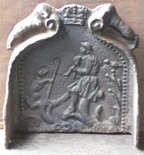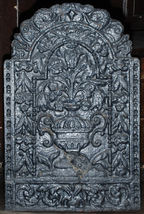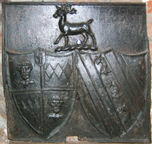-
1128
Description: Quasi-arched shape with forward-facing 'wings', which splay outwards towards the base; the 'wings' curve to follow the shape of the main panel but curl outwards at the top; central panel with pictorial image of, to the right, a shepherd holding a musical pipe, his right foot upon a log, upon which a dog, to the left, sits holding the shepherd's crook; top centre, a crown, on either side of which, on the curled upper parts of the 'wings', is an inward facing sheep.
Notes: Nothing is known about the sources of free-standing firebacks or what prompted their production. Their form is similar but the predominant use of horticultural or arboreal decorative themes, which suggests production within a limited time frame, has in this instance been replaced with a humorous scene. Only a very small number of such castings are known. Depth 210mm
- Decoration tags:
- free-standing (shape)
- none (edging)
- whole carved pattern
- heraldic
- pictorial
- animals
- humans
- plants
- objects
Manufactured: in the late-17th to early-18th century in England.
Current location: not known.
- Attached to series:
- Free-standing firebacks
-
654
Description: Arched rectangular central panel with bead-and-pellet edging; S-scroll, two-handled, gadrooned vase with tulip stems, flowers and leaves; arched rectangular border with fillet edging and suspended flower bunches; along a rectangular bottom panel with fillet edging a symmetrical arrangement of swirled foliage; on top, two symmetrical, coiled serpents; narrow, curved shouldered side panels with beads in oval depressions.
Notes: The presence of tulips suggest a Dutch origin for the pattern of this fireback, although the presence of several examples in England suggest that it was produced here rather than on the Continent.
Copies of this fireback are known.
- Decoration tags:
- 'Dutch' (shape)
- fillet (edging)
- whole carved pattern
- extension panels
- pictorial
- plants
- objects
Manufactured: in the mid-17th century in England.
Current location: Eastgate House, High Street, Rochester, Kent, England.
Museum number: A3507 (part of the Rochester Guildhall Museum museum group)
- Attached to series:
- Flower Vase 'Dutch' types
- British 'Dutch' style firebacks
-
1031
Description: Rectangular; astragal and fillet edging; two heater-shaped shields side by side, with a stag trippant crest above centre.
Notes: The dexter shield: quarterly first and fourth - Mostyn baronet - Gules a saracen's head erased proper wreathed about the temples sable and argent; second and third, within a bordure a fess fusily (or three lozenges in fess); a baronet's inescutcheon in the centre chief. The sinister shield - Sale - Argent on a bend cotised three gryphons' heads erased. Crest (Mostyn), a stag trippant proper.
Arms: Left: Mostyn with unknown quartering; right: Sal, Sale, Salle or Salley
- Decoration tags:
- rectangular (shape)
- astragal & fillet (edging)
- carved stamps
- heraldic
- armorial
- animals
- humans
Manufactured: in the 19th century in England.
Current location: in private hands, Saxtead, Suffolk, England.
- Attached to series:
- Personal armorial firebacks


